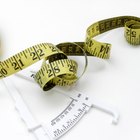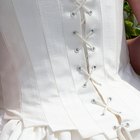
Yamini Chao/DigitalVision/Getty Images
Being able to wear a certain clothing size doesn't necessarily mean you're at a healthy weight. Your ideal weight depends on your age, your body composition, your height and your body type. Dress sizes can't take all of these into consideration. Your doctor -- rather than dress manufacturers -- can help you determine whether you're at a healthy weight.
Lack of Standards
No standard dress size exists among manufacturers -- so while you might wear a 6 in one brand, you find you're a 10 in another. Apparel companies base their sizes on their particular client base. Higher end designers' sizes tend to run smaller, Elaine Perlov, a marketing manager and designer, told Weight Watchers. Mass-marketed brands use sizing to entice customers. These companies believe you're more likely to purchase their products if you can fit into what you perceive to be a smaller size.
Cuts and Style
The cuts of clothing also vary among manufacturers and determine fit -- but have no bearing on whether you're at an ideal weight. Some may be more generous in the bust or waist than others, even though the size on the tag reads the same. You may be of a healthy weight but need a larger size to accommodate longer legs, a more generous chest or thicker arms. The average woman actually wears a different size on the top than on the bottom -- a 12 on top and size 14 bottom, notes George Simonton, design director of his self-named label, and professor at Fashion Institute of Technology. You may also be able to squeeze into a smaller size in a dress with a boxy cut, while you may need to go up in a dress that's form-fitting, even if both are made by the same designer.
Determining Ideal Weight
Ideal weight is a range, not a specific number on a tag. A body-mass index, which is determined using a ratio of your height and waist size, of between 18 and 24.9 generally means your weight is healthy. BMI has its limitations, so you should also measure your waist to determine whether you're carrying too much extra belly fat. A waist larger than 35 inches on a woman indicates a potentially unhealthy weight. Being able to fit into small sizes, especially if you're tall, isn't ideal, either. It could be an indication that you're underweight.
Not Made in America
International sizes are also inconsistent among manufacturers and countries, and can't help you determine if you're at an ideal weight. In theory, a European size 34 might be the equivalent of an American size 4 and a 36 equal to a size 6 -- but with the disparity in American sizes, it's impossible to draw such a correlation. Even within Europe, sizes vary despite listing identical numbers on the label. For example, German and Italian sizes may run larger than those that come from France. Asian sizes tend to run small when compared to the U.S. and Europe. Asia even features a "junior plus" size, which is an equivalent of plus-sized clothing. Those plus sizes, though, correlate with more like a 12 to 14 in the United States, which is not considered plus-sized here.
The Bottom Line
Focus on getting to a weight that supports good health with a healthy, balanced diet and more physical activity, rather than fitting into a particular size of dress. The randomness with which clothing manufacturers set dress sizes is designed to feed your ego, and not to help you determine your ideal weight.
Related Articles

How to Read Measurements on a Dress ...

How to Convert Girls' Clothing Sizes to ...

What Is Comparable to a Size 10 Dress ...

Difference Between 44S & 44R Suits

What Body Type for a Drop-Waist Dress?

Clothing Styles for Big Butts

Dress Styles for Small Busts

How to Convert Children's Clothing Size ...

What Kind of Body Types Do Levi's Jeans ...

What Do Denier Numbers Mean?

Difference in Misses, Juniors, and ...

The Differences Between Slim Fit and ...

What Does Bust Size Mean?

What Size Shirt Is a 4X for Men?

How to Size an Overcoat

How to Make a Plus-Size Person Look ...

Good Leotards for Big Busts

Lacoste Vs. Ralph Lauren

Difference Between Male & Female Pants

How Do I Buy a Girdle for a Man?
References
Writer Bio
Andrea Cespedes is a professionally trained chef who has focused studies in nutrition. With more than 20 years of experience in the fitness industry, she coaches cycling and running and teaches Pilates and yoga. She is an American Council on Exercise-certified personal trainer, RYT-200 and has degrees from Princeton and Columbia University.
Photo Credits
Yamini Chao/DigitalVision/Getty Images